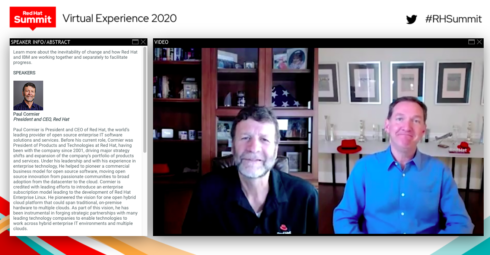
While everyone in the world is separated from their friends, families, and co-workers during the COVID-19 pandemic, Red Hat wants to remind us about the importance of staying connected and collaborating. The company kicked off its first virtual Red Hat Summit this week to talk about its open hybrid cloud vision, products and partnerships.
“We still think it is really important for us to gather and exchange ideas on the state of open source and the state of enterprise IT industry and where it is all going,” said Paul Cormier, keynoting his first summit as president and CEO of Red Hat. “It may be even more important at this time to take this time to be with you, listen to you and figure out how we can help each other.”
Cormier opened the virtual event by talking to Jim Whitehurst, former Red Hat CEO and now president of IBM, about Red Hat and IBM’s new dynamic. Red Hat was acquired by IBM last year for $34 billion, and since then the two companies have worked to keep Red Hat separate.
“The biggest topic on everyone’s mind is innovation. How do you innovate? Because we went from a world where value creation was much more about how you executed and made things of higher quality cheaper, and now value creation is so much more about growth. It is how you invent new things. It is how you create whole new markets that didn’t exist before. How do you invent new ways to interact with your customers and so this idea of how you actually innovate is taking center stage,” said Whitehurst.
When it comes to innovating, IBM leverages Red Hat’s technology and expertise to augment its portfolio of technologies and run across multiple cloud environments. IBM also works with Red Hat to help it scale and support its platform, but aims to do so in a way that Red Hat “stands alone.”
“The issue has always been obviously to land a horizontal platform. The company that lands that platform, the same thing we did with Linux, needs to be able to work with everyone in the ecosystem,” said Whitehurst. “IBM is able to help scale Red Hat’s open hybrid environment, but it competes with that ecosystem.” By keeping Red Hat separate, it is able to ensure its platform is “neutral, available to anyone, that any customer, client anywhere can feel comfortable if they are working with Red Hat, they can work with whoever else they want without any type of conflict.”
Cormier also provided more insight into Red Hat’s open hybrid cloud vision.
“This has been our vision for many, many years. It has driven our portfolio strategy. Every new product and every M&A over the last few years has been to fit into this vision,” he said.
To Red Hat, open refers to achieving innovation faster than was possible before. “Open solves problems that any one company with a single company agenda might not do on their own. Open takes the best ideas from all perspectives and allows the best idea to win,” said Cormier. It does this by having the community collaborate together to solve problems without thinking what is best for a person or company.
Hybrid refers to the power of choice. “Hybrid means meeting you wherever you are. Helping you future-proof what you have today, and what you are going to build tomorrow. Hybrid is the reality for now and for a very long time to come,” Cormier said. Hybrid gives users the ability to run apps on any footprint that makes sense for them with a common development, operations, security and automation environment.
Lastly, cloud gives developers the agility to build apps and services anywhere, at any time.
“Applications should be able to move freely based on what is right for the business with a consistent experience and operational controls,” said Cormier. “Today cloud is more how we consume technology in a seamless way. Cloud today extends from on-prem to multiple public clouds and all the way out to the edge.”
“Open hybrid cloud is what we are delivering to our customers and building with our partners every day, today, and tomorrow,” Cormier added.






